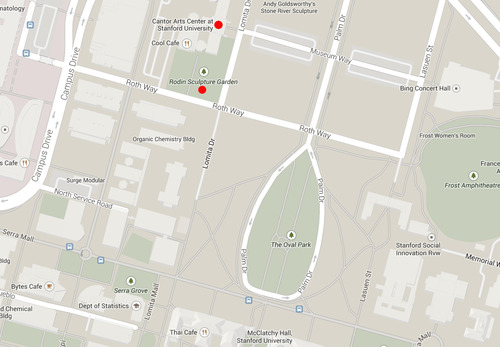
Rodin Village, South-Central Stanford University
I’m visiting my parents in San Francisco and, like all children of parents on the other side of 77, wondering what we can do all together. The parents hate noise, crowds, and lines. And in fact, Dad is fit as a fiddle but alas an immovable object. Mom is more of a free spirit but hates leaving dad at home alone. I don’t mind, at 80 he’s clearly a survivor. I’m obviously younger but there’s some genetics at work. I too hate noise and crowds.
It turns out that not too far south of San Francisco you can visit one of the best collection of Auguste Rodin sculptures outside of Paris. Stanford University, also known as The Farm, is as quiet and laid-back as humanly populated areas can be. The uni’s Cantor Arts Center has an entire village of Rodins.
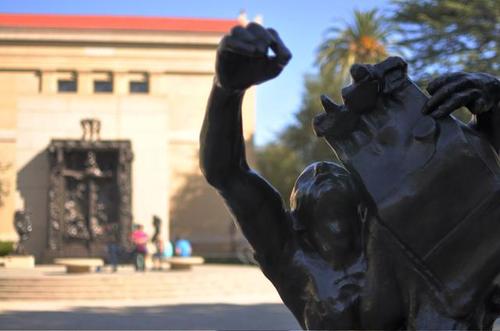
Beware thee who enter here. Cantor Arts Center. By Rob Szumlakowski.
And parents love Rodin. Nonetheless, Dad ain’t going nowhere, afterall, it’s a 35 minute drive, and that’s without traffic! There’s the unsolvable parking problem. And you can see the Rodin’s on the iPad at home, in a comfortable chair. But Mom is ready to head south.
So we hurtle down an evergreen highway in Mom’s bright red VW Beetle.
The Stanfords ran a posh horse-breeding farm 120 years ago. Stanford today is still acres of wild land but now with a smattering of sandstone Greek temples, columns and arches and patios. Rodin’s garden is in south-central Stanford.
My dad was right about one thing, the parking. The place has unlimited wealth but charges for parking. We don’t notice this and get a $45 ticket (Dad: 1, Us: 0).
The main entrance to the Cantor Center is dead boring so we turn left and head for the Rodin village.
We are the species that produced twerking and the wolverine banana.
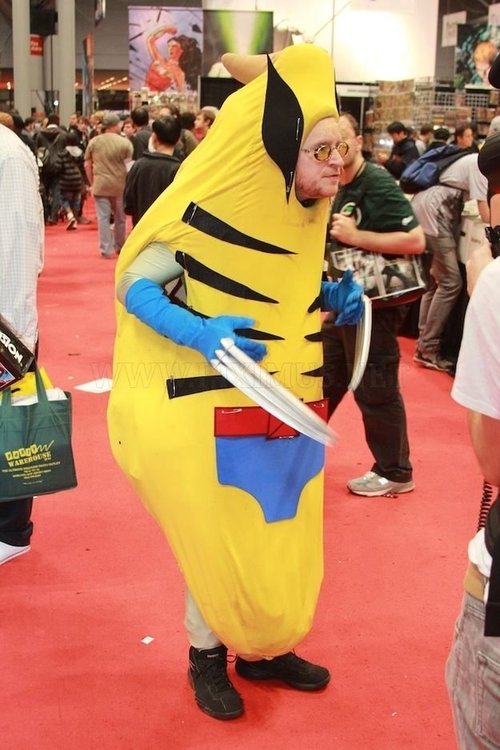
At a loss for words. Wolverine Banana at Comic-con. Found on Reddit.
Its therefore remarkable when you enter the little village of bronze men, two women, a head and a walking torso, that a human, one of us, has made such amazingly warm life-like and moving figures out of cold metal.
Mom makes for The Three Shades. It looks tragic. In fact several of the sculptures in the garden are so alive in their torment that you pretty much have to look away. What are these three guys looking at? And why the painfully twisted neck?

Down below its bad. The Three Shades. Photo by P. Houtzager.
The guy who designed the garden turns out to be a sneak. We only learn what Three Shades is all about in the grand finale of the walkabout. In the meantime, we zigzag around the dark bronze dramas playing out in the garden. This is nothing like Rodin’s lovey-dovey The Kiss. There are a few optimistic and minutely detailed tributes to friends, but for the most part its horror and suffering.
Walking behind Three Shades I discover something no one else has ever mentioned. Rodin is the master of the male buttock. He’s pretty remarkable with all body parts, but the buttocks are to die for. You think I’m kidding but look…
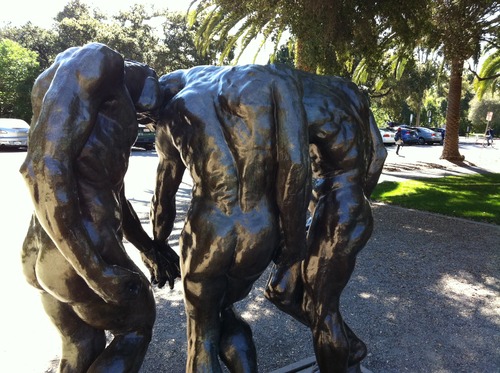
Master of the male buttocks. Behind Three Shades. Photo by P. Houtzager
It’s from behind that Rodin’s genius can stop anyone’s heart. They are not perfect, but the small imperfections make each cheek unique, credible, and lovely.
Mom is no prude but she ignores the ripe fruit.
Her favorite sculpture is a surprise. It’s the head of Pierre de Wissant, distorted in pure unvarnished terror. The miserable Wissant is off to his execution by the English as one the Burghers of Calais. This is a while ago, 1347 to be exact, and England’s Edward III promised to end his brutal siege of Calais, and starving its people, if the city coughed up six of its leaders. The heroic volunteers had to come out with nooses around their necks and with the keys to the city and castle.
To me it looks like the head has been pulled out of an intensely gruesome car crash, but mom claims she’s drawn to the depth and truth of Wissant’s feeling. Rodin somehow captures the beauty in the horror of Wissant’s situation. Ok then.
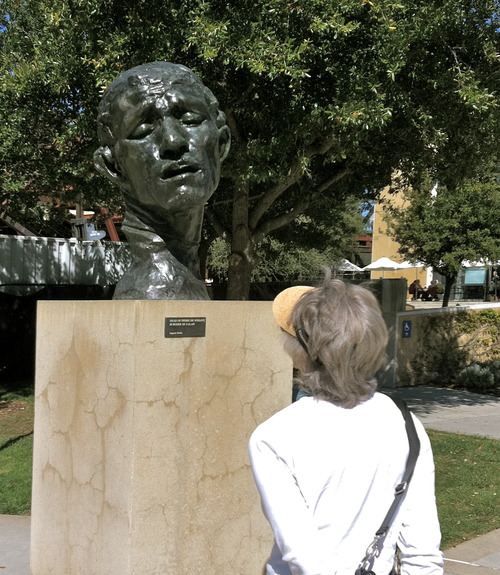
Mom and about-to-be-executed Burgher of Calais, Pierre de Wissant.
After this, we really need a break. The coffee shop is a treat. The patio has well targeted parasols; the apple pie is to die for; and the cappuccino rich and full.
Back to the village walk. It ends, Rodin style, in hell, captured in agonizing detail. Literally. You don’t have to be Catholic to shudder at the horror of bodies jutting out from the scorching lava that makes up the Gates of Hell.
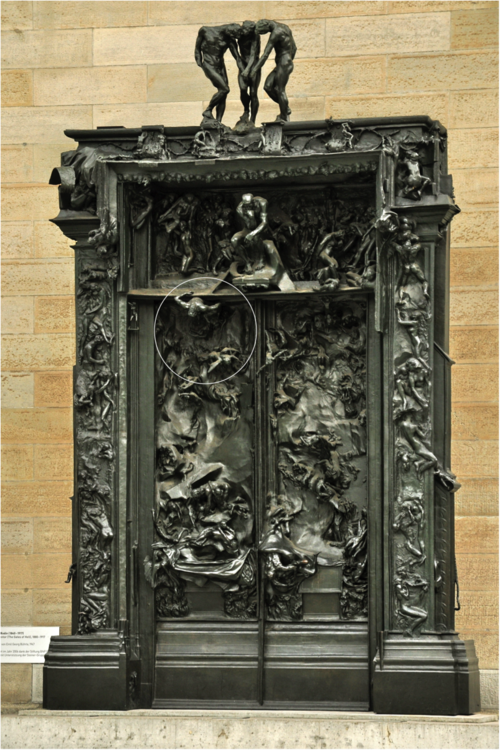
Most of my future work in 6 x 4 x 1 (deep) meters. The Gates of Hell. Zurich Kunsthaus.
Rodin’s family was intensely Catholic, and when his sister, a nun, died at a young age Rodin’s grief led to poor decision making and he gave himself up to a religious order. After six months the head brother told Rodin to go home and sculpt and be a genius, which he did.
He started Gates of Hell a few years after sister’s death, though the inspiration Rodin acknowledges is Dante’s Inferno, the book cover of which we have all seen in high school. I can’t remember a word but I think each type of sinner has their own ring in hell, with the worse sins down on the lower and hotter rings. The Gates contains what would become many of his most famous works: The Thinker, Three Shades, Adam and Eve…
The detail below shows again his unfathomable grasp of the male buttocks, and also of feet. The shoulders capture the pain, the buttocks are clenched and riding high on the arched lower back.

Close up of “Everything is Lost Guy”. Photo and nickname by P. Houtzager
The Rodin collection goes on indoors. A super friendly and knowledgeable museum chap explains that Rodin sculpted in clay and other people wearing some protective gear poured piping hot bronze into casts made from those clay sculptures. So Rodin was never in much danger himself. The chap also observes that this kind of casting is really great because you can make an unlimited number of copies of a sculpture. For example, there a 45 authorized copies of The Thinker alone, and an unknown number of unauthorized ones made by enterprising foundries in Paris. Each authorized copy is considered and sells as an ‘original!’
Who knew? And what a racket.
In Room 2 we realize that the Art Center really does have an awful lot of Rodin’s stuff. No fool, Rodin sculpted body parts that he assembled in different ways in different sculptures. One hand might get attached to several figures. Ditto a torso, maybe even a head.
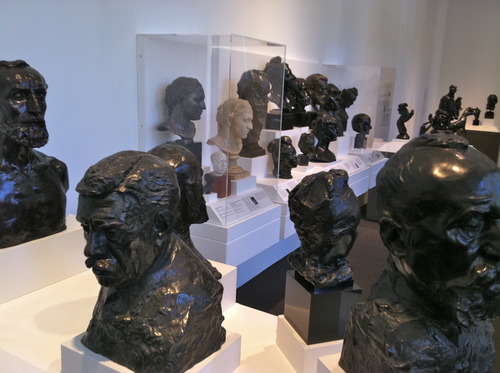
Heads up. Room 2 of the Cantor Center.
Bleary eyed from all the bronze, Mom observes that Rodin doesn’t do animals. True, not a one. Maybe he doesn’t like them, or maybe he’s 100% dedicated to sorting out how to inflict maximum suffering on bronze people. A good Rodin biography might tell us, but we haven’t read one. Now we probably will.
On the way out of the building we have an awkward moment with Robert Arneson. He loves a good self-portrait and gets as over the top as you possibly can. The odd thing is, after all the Rodin Mom and I both stop and look closely. The wacky pale plaster of Assassination of a Famous Nut Artist is off-beat, slightly disgusting kitsch relief. The green booger crawling out of the nose is a nice touch, gross in way we can handle.
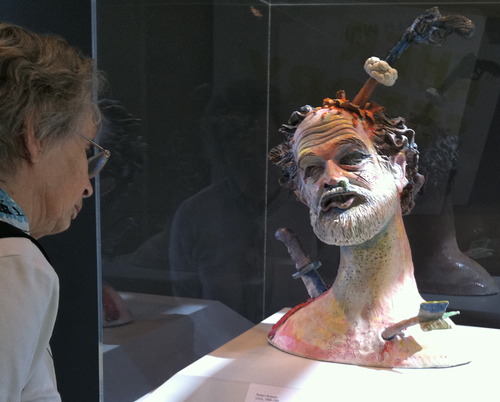
Mom and Assassination of a Famous Nut Artist. Robert Arneson, 1971. Photo by P. Houtzager
Much later we learn that there’s a full casting of the famous and long-suffering Calais Six in another campus courtyard. The Cantor Center might have told us, and other dedicated patrons of the arts. But no matter, I doubt we could have taken in more of Rodin awesomeness in one trip.
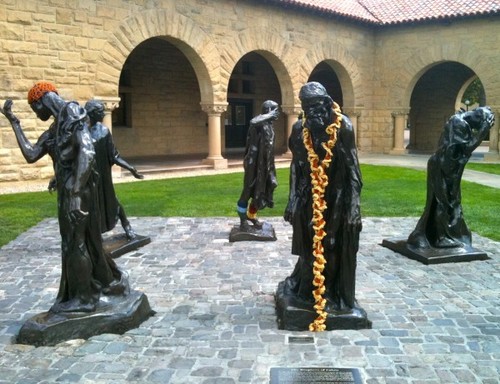
Those wacky students, smartening up the Burghers of Calais in Spring. From The Unofficial Stanford Blog.









